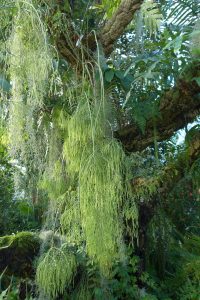Audio by David Mitchell from 2005
As you walk in to this house you are greeted by the heat and humidity of a South American rainforest, one of the most diverse ecosystems on the planet. The planting in this house has bought many species which would naturally be found high up in the canopy down to a level at which you can appreciate the vivid colours of their flowers and varied leaf shapes. The bromeliads which are growing on the central tree and alongside the footpath are a prominent feature, they are a large family, with over 2,000 species. The leaves, which spiral around a central hollow, have given rise to the common name urn plant, as water collects in this hollow and acts as a home for numerous other species.
If you follow the path alongside the bromeliads to the back corner you will come across two members of the same genus in the Aristolochiaceae. If you look on the wall you will see a vine with large, more or less triangular leaves, this is Aristolochia grandiflora. When in bloom it has large (up to 30cm), floppy flowers which are mottled dark maroon and white. Near to this is the second member of this genus, Aristolochia arborescens, in contrast this is a small tree, with flowers appearing at its base. Like its relative the flowers are maroon and white in colour and both produce a rather unpleasant scent a bit like rotting meat, this is because they are pollinated by flies, which get trapped in the complex structure of the flower. This trapping ensures the plant is able to cover the fly in pollen, when the fly is released it will carry the pollen to another flower, ensuring pollination occurs.
Once you have crossed the bridge and are near the entrance to the next house take a look at the tree next to the pond. In its branches are several cacti, including members from the genus Rhipsalis. Unlike the ones you will see in the next house these are epiphytic (they grow on other plants), and are found in tropical regions of South America. Like most cacti they have no leaves, but the spines which are typically associated with cacti, are greatly reduced or absent, as they are not grazed and so don’t need the protection. There is another unusual cactus in this house, it is growing next to the wall to the left of the door to the Arid lands house. This is Pereskia, it has a tree like stem with bunches of spines coming from it, but unlike most cacti it has ordinary leaves. This is because it is a primitive member of the family, from which the ‘classic’ desert cacti have evolved.




2 Comments
2 Pingbacks